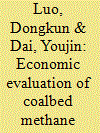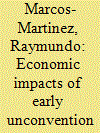|
|
|
Sort Order |
|
|
|
Items / Page
|
|
|
|
|
|
|
| Srl | Item |
| 1 |
ID:
177140


|
|
|
|
|
| Summary/Abstract |
As coalbed methane, the natural gas adsorbed in coal seams, is a greenhouse gas that is 21 times stronger than CO2, coalbed methane extraction significantly influences carbon reduction and energy conservation efforts. While the injection of CO2 into coal seams is known to effectively enhance coalbed methane recovery, this process has been limited because of high investment and production costs. Therefore, to promote the application of CO2 injection techniques in coalbed methane industry, this paper proposes an authority–enterprise equilibrium based mixed subsidy mechanism which combines direct subsidies with indirect tax-incentives. Specifically, a multi-objective bi-level programming model is established under uncertainty to assign a practical constraint and achieve a trade-off between the local authority and the coalbed methane plants. A practical case validates the feasibility and efficiency of the proposed method, proving that an authority–enterprise equilibrium based mixed subsidy mechanism is able to achieve carbon emissions reductions and conserve energy. Further analysis indicated that the marginal energy efficiency gains were greater than the authority costs under a strict energy utilization policy and that the environmental protection target had larger impacts on the coalbed methane plant performances.
|
|
|
|
|
|
|
|
|
|
|
|
|
|
|
|
| 2 |
ID:
091545


|
|
|
|
|
| Publication |
2009.
|
| Summary/Abstract |
Roaring natural gas demand, energy security and environment protection concerns coupled with stringent emission reduction requirement have made China's abundant coalbed methane (CBM) resource an increasingly valuable energy source. However, not all of China's CBM resource is economic to develop under current technological condition and economic situation. In order to locate the CBM resource with economic viability to develop in China, economic evaluation of CBM production is conducted by applying net present value (NPV) method. The results indicate that more than half of CBM resource in China is economic to develop. It shows that CBM price, production rate and operating costs are the three major factors with most impact on the economic viability of the CBM development in target areas in China. The result also demonstrates that the economic limit production is roughly 1200 cubic meters per day. These economic evaluation results provide important information for both CBM companies and China government.
|
|
|
|
|
|
|
|
|
|
|
|
|
|
|
|
| 3 |
ID:
162970


|
|
|
|
|
| Summary/Abstract |
Globally, the development of the unconventional natural gas (UNG) industry is expected to continue as gas consumption increases in the transition to cleaner energy sources. However, social and regulatory factors may constrain UNG activity at regional scales. Robust impact assessments of the effects of the UNG industry at different phases of development could help reduce trade-offs of energy policy and promote overall welfare improvements. We assessed if the early phases of the coal seam gas (CSG, a type of UNG) industry in New South Wales, Australia produced regional economic changes between 2001 and 2011. We combined spatial econometrics, genetic matching algorithms and seemingly unrelated regressions with instrumental variables to control for multiple factors influencing regional economic patterns (e.g., climate, human capital) to estimate the effect of the CSG industry on local income and employment. Results show that regions with CSG activity had 7% (±5%, 95% C.I.) higher family income than regions without CSG mining. No statistical evidence of indirect employment multiplier effects from CSG activity were found. The analysis can inform social license and regulatory decisions related to the CSG industry that impact competing social priorities such as energy and water security, economic growth and environmental health.
|
|
|
|
|
|
|
|
|
|
|
|
|
|
|
|
| 4 |
ID:
171490


|
|
|
|
|
| Summary/Abstract |
Unconventional oil and gas (UOG) projects have emerged as fundamental, yet often controversial, components of contemporary energy systems. In contrast to the prevailing academic focus on sites of conflict, this paper explores why and how the social license to operate succeeds in UOG settings, or how private landowners accept or accommodate development. This paper applies the concept of social license to operate to landowner-industry relations during an episode of coalbed methane (CBM) development in the Powder River Basin, Wyoming. Conclusions draw on forty semi-structured interviews with stakeholders, including industry personnel, oil and gas attorneys, and surface owners that hosted CBM development. The findings indicate that mutual respect, procedural fairness, and trust were necessary preconditions of social license. These three preconditions created an opening for surface owners to effectively engage in private participation and advocate for their instrumental priorities. However, the key priority of surface owners to retain energy infrastructure, instead of demanding reclamation, has contributed to the existing U.S. land-use phenomenon of energy sprawl. Therefore, reclamation policy should aim to secure positive personal outcomes for private surface owners while mitigating against the cumulative environmental impacts of energy production.
|
|
|
|
|
|
|
|
|
|
|
|
|
|
|
|
|
|
|
|
|